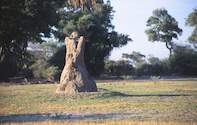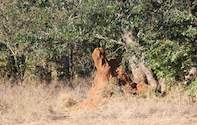
The termite mound is one of the characteristic features of the African landscape, where structures of all shapes and sizes can be observed on the savannahs.
Having been around for over 50 million years the termite is one of the oldest, and most adaptable, species on earth. Many people around the world think of termites as pests that destroy gardens and homes, and though there is truth in the destructive qualities of these ancient creatures the majority of termite species actually serve an important role in the environment.
Termites of Africa and the World

There are more than 2700 known species of termites on earth, all of which operate on a caste system where colonies have a king and queen, workers, soldiers and fertile individuals, or aletes. In some species the workers are also the soldiers and in other species the soldiers are fertile and go on to become the kings and queens, but in general colonies have the four caste system.
The different species of termites feed on a range of plant material, from grass and shrubs to dead or decaying wood. Many species of termites survive on dead organic matter, able to convert this matter to food through a fungus in the gut that is passed on through the generations. It is this ability to convert dead matter to food that is responsible for the termite being classed a pest as it destroys the wooden structures of buildings.
But it is in Africa
The study of termites can be a fascinating pastime, but it is the mound builders that provide the most dramatic example of termite activity. These termite mounds are found in various parts of the world, with Africa been the place where they seem to enhance the landscape the most and where the life cycle is best demonstrated.
At specific times of the year, generally after the first rains of the season have fallen, the African 'landscape' is filled with the sight of winged insects scurrying about in frenzied dashes to nowhere as predators across the spectrum feast on the bounty. These winged insects are the fertile individuals of the termite colonies that have been waiting for the ideal conditions to occur before alighting on a do or die nuptial flight in order to find mates and start new colonies.
Watching the predatorial [predator] orgy, where the termites are hunted in the air and on the ground, you wonder how they could have survived as a general for so long, but later the realisation sinks in that with such numbers some are bound to escape the predators and find mates.
Despite all the predators that feed on the newly released termites a few do survive, of which the females will attempt to attract males by releasing pheromones into the air. When a male responds there will be a short foreplay before the mating, after which the couple dig a hole in the ground or log, hollow out a chamber and start the new colony. The first eggs the female, or queen, lays will produce worker termites that will begin to collect food and enlarge the structure.
The Last Survivors
A species has to be successful to adapt and survive for over 50 million years and it is said that the termite is one of the few creatures that will survive a natural disaster or nuclear holocaust.

 I have often been ridiculed for my fascination with 'dung and dust'. In today's mindset, a wilderness experience is considered primarily a b...
I have often been ridiculed for my fascination with 'dung and dust'. In today's mindset, a wilderness experience is considered primarily a b... Discover incredible insights into Botswana's wildlife behaviour, from predator-prey dynamics to migration habits. Explore how animal behavio...
Discover incredible insights into Botswana's wildlife behaviour, from predator-prey dynamics to migration habits. Explore how animal behavio...